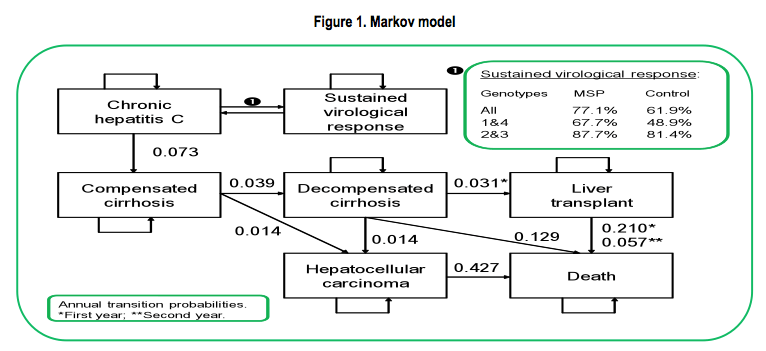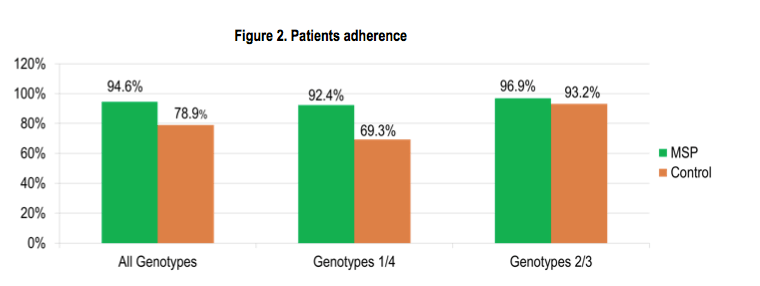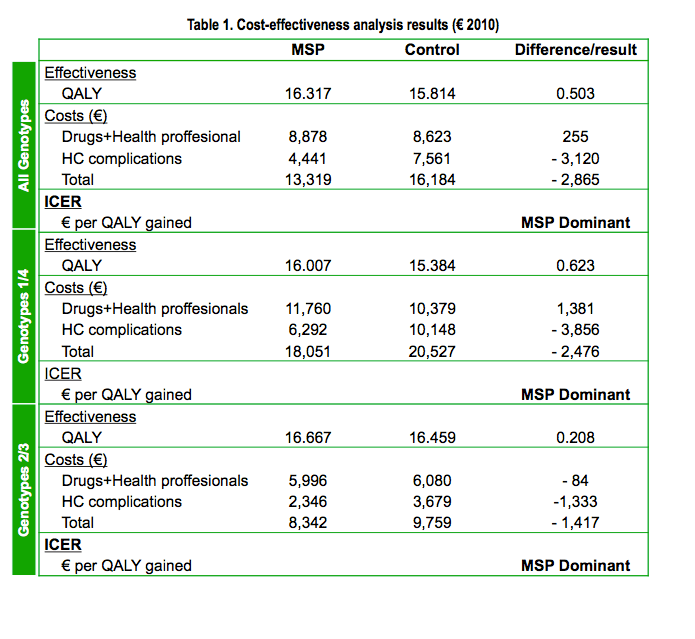 |
 |
 |
| |
Cost-effectiveness analysis of a multidisciplinary
support program in hepatitis C treatment
|
| |
| |
Reported by Jules Levin AASLD SF Nov 5-8 2011
Garcia-Retortillo M1, Cirera I1, Gimenez MD1, Márquez C1, Cañete N1, Carrion JA1, Castellvi P1, Lázaro D1, Navines R2,3, Castaño JR4, Urbina O5, Salas E5, Bory F1, Martín-Santos R2,3, Rubio-Terres C6, Martín-Escudero V7, Solà R1
1 Liver Section, Hospital del Mar. IMIM. Universitat Autònoma de Barcelona. 2 Departments of Psychiatry and Psychology, Institute of Neurosciences, Hospital Clínic, Universitat de Barcelona, IDIBAPS. 3 Neuropsychopharmacology Programme, IMIM. Hospital del Mar. 4 Psychiatric Department, Hospital del Mar. IMIM. 5 Pharmacy Department, Hospital del Mar. Barcelona. Spain. 6 Health Value. Madrid. 7 Roche Farma. Madrid
CONCLUSION
Antiviral treatment of hepatitis C with Peg-IFN-alfa-2a and ribavirin in MSP improves the compliance and increases the efficiency compared with the conventional approach, being a cost-effective strategy.
BACKGROUND & OBJECTIVE
·The adherence during antiviral treatment in hepatitis C (HC) is an important factor to success the virological response.
·Aim: To develop a cost-effectiveness analysis of a multidisciplinary support program (MSP) versus the conventional approach during antiviral treatment.
METHODS
· 278 mono-infected naive consecutive HC patients were included. All patients were treated with Peg-IFN-alfa-2a (Pegasys®) plus ribavirin. One hundred thirty one patients were included in MSP group and 147 patients were conventionally controlled (control group).
· The MSP team included hepatologists, nurses, pharmacists, psychologists and assistants. The control group included hepatologist s and nurses.
· Standard patient education, open and flexible visits scheduling, continued psychiatric evaluation and active medication were carried out in the MSP group.
· Adherence to the treatment, sustained virological response (SVR), and health resources use were evaluated in both groups.
· The cost-effectiveness analysis was performed using a Markov model for a lifetime horizon with seven health states and from the Spanish NHS perspective (Figure 1)1,2.
· Transition probabilities and health states utilities were obtained from published literature 1,2.
· Drugs costs, costs related to complications associated to the disease and costs of the professionals' time twere obtained from the Catalogue of Medicinal Products and from Spanish studies and databases ( 2010).
· 3.5% annual discount for costs and outcomes were applied.

RESULTS
· MSP improves compliance with treatment for hepatitis C and increases its sustained virological response, especially in patients with genotype 1.
· Treatment compliance rate was higher in the MSP group (94.6%) compared with the control group (78.9%) (p=0.0001) (Figure 2).
· SVR was higher in the MSP group than in controls for all genotypes (77.1% vs 61.9%, p=0.006), genotypes 1/4 (67.7% vs 48.9%, p=0.02), and genotypes 2/3 (87.7% vs 81.4%, NS)3.

· In the analysis of all genotypes, the cost per patient including cost of drugs, health professionals and long-term complications associated to the disease was 13,319 in MSP group and 16,184 in control group (Table 1).
· Furthermore, MSP group resulted more quality adjusted life years (QALYs) than controls (16.317 vs 15.814). MSP was dominant (more effective, with lower costs) compared with the conventional approach (Table 1).
· The MSP program was dominant in patients with genotypes 1/4 (saving 2,476 and increasing 0.622 QALYs per patient) and genotypes 2/3 (saving 1,417 and gaining 0.208 QALYs per patient) (Table 1). These results were stable for 95% CI of drug doses.

|
| |
|
 |
 |
|
|